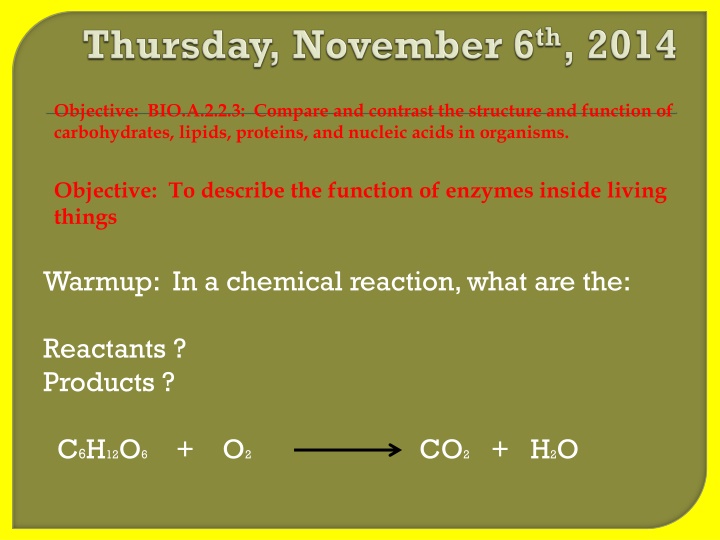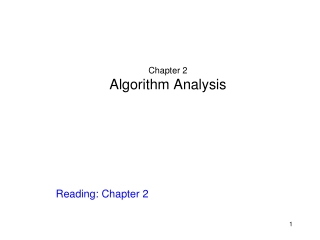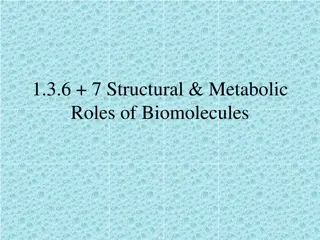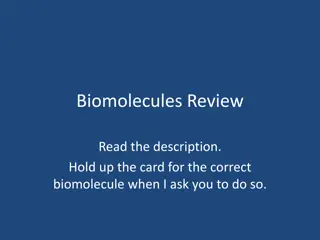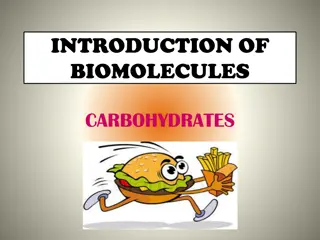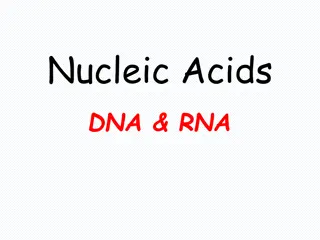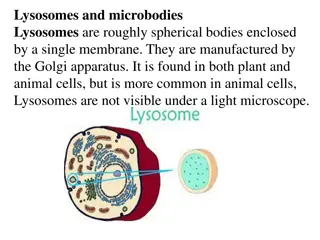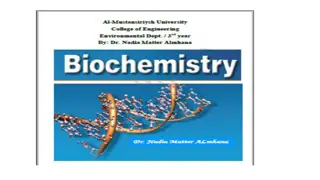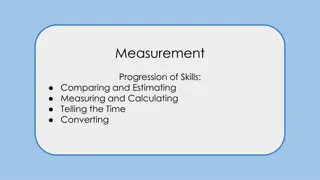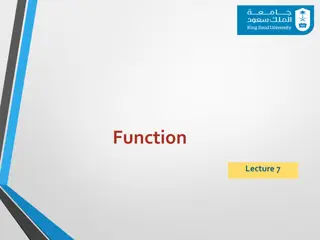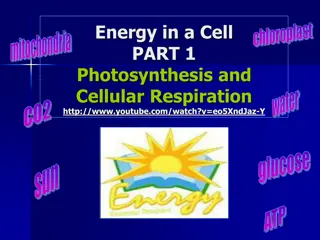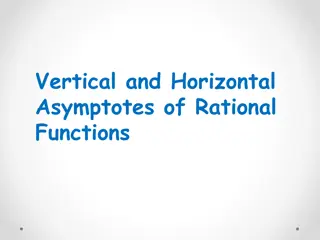Comparing Biomolecules' Structure & Functions
The structure and function of carbohydrates, lipids, proteins, and nucleic acids in organisms, along with the role of enzymes in catalyzing biological reactions. Understand how these biomolecules interact to sustain life processes and energy flow within living systems. Dive into the basics of chemical reactions, reactants, and products while elucidating the critical function of enzymes as biological catalysts in lowering activation energy barriers for efficient reactions.
Download Presentation

Please find below an Image/Link to download the presentation.
The content on the website is provided AS IS for your information and personal use only. It may not be sold, licensed, or shared on other websites without obtaining consent from the author.If you encounter any issues during the download, it is possible that the publisher has removed the file from their server.
You are allowed to download the files provided on this website for personal or commercial use, subject to the condition that they are used lawfully. All files are the property of their respective owners.
The content on the website is provided AS IS for your information and personal use only. It may not be sold, licensed, or shared on other websites without obtaining consent from the author.
E N D
Presentation Transcript
Objective: BIO.A.2.2.3: Compare and contrast the structure and function of carbohydrates, lipids, proteins, and nucleic acids in organisms. Objective: To describe the function of enzymes inside living things Warmup: In a chemical reaction, what are the: Reactants ? Products ? C6H12O6 + O2 CO2 + H2O
Composed of chains of amino acid monomers with a three-dimensional shape that controls their function. Act as biological catalyst they lower the amount of activation energy needed to start a reaction.
The lower the activation energy, the more products can be produced efficiently.
Objective: BIO.A.2.2.3: Compare and contrast the structure and function of carbohydrates, lipids, proteins, and nucleic acids in organisms. Objective: To describe the function of enzymes inside living things Warmup: In a chemical reaction, what are the: Reactants ? Products ? C6H12O6 + O2 CO2 + H2O
Period 3 Objective: BIO.A.2.2.3: Compare and contrast the structure and function of carbohydrates, lipids, proteins, and nucleic acids in organisms. Objective: To describe the function of enzymes inside living things Warmup: 1.) What elements make up: carbohydrates? lipids? proteins? enzymes?
Enzymes are designed to work with one particular molecule because shape determines what molecules will work together.
Enzyme Catalyzed (sped up) reaction Amylase Hydrolysis of starch Maltase Hydrolysis of maltose Sucrase Hydrolysis of sucrose Catalase Hydrolysis of hydrogen peroxide *Enyzmes can often be identified by the suffix ase *
Key Terms: Substrate molecule to be acted on Active site area of enzyme that fits with substrate Enzyme-Substrate Complex substrate + active site of enzyme
Key Points: Enzymes themselves do not change shape or function while they speed up a reaction, unless they are denatured. Enzymes are not used up during a reaction they can be used over and over again.
Temperature Low (0 C) = decreased kinetic energy of enzymes and substrates. oEnzymes are inactiveand don t move. oNo/few enzyme-substrate compounds are formed. oRate of reaction decreases. 1.
Temperature Increasing (20 C) = increased kinetic energy of enzymes and substrates. oEnzymes increase their movement. oIncreased enzyme-substrate compounds are formed. oRate of reaction increases. 1.
Temperature Optimal Temperature (for most enzymes ~37 C) oTemperature at which the enzyme works best oRate of reaction is the highest 1.
Temperature Beyond Optimal Temperature (>60 C) oWeak bonds within the enzymes are broken. Enzyme s shape and function fall apart leading to a loss of function. This is called denaturation. 1.
pH Enzymes work best within a narrow pH range Each enzyme works best at its optimum pH level 2. At extreme pH levels, enzymes lose their shape and function and become denatured.
1) Enzymes help organisms by A. providing energy. B. building proteins. C. packaging proteins. D. reducing the amount of activation energy required to start a reaction.
2) In a reaction that takes place in the presence of an enzyme, the substrate binds with the enzyme. Which statement best describes what happens to the enzyme as the substrate is converted to the product? A. It is denatured. B. It remains unchanged. C. It becomes part of the product. D. It becomes a part of the substrate.
The diagram below represents a human enzyme and four types of molecules present in a solution. 3. Which molecule would most likely react with the enzyme?
The graph shows how the activity of an enzyme changes at different temperatures. 4. Which statement best describes what happens to the enzyme when the temperature of the reaction increases to 63 C? A. The enzyme is used up and the reaction stops. B. The enzyme begins to decrease the rate of the reaction. C. The enzyme continues to increase the rate of the reaction. D. The enzyme changes shape and can no longer speed up the reaction.
